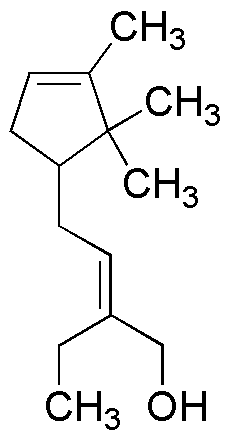2-Ethyl-4-(2,2,3-trimethylcyclopent-3-en-1-yl)-but-2-en-1-ol is widely utilized in research focused on:
- Fragrance Industry: This compound is often used as a fragrance ingredient in perfumes and personal care products, providing a unique scent profile that enhances product appeal.
- Flavoring Agents: It serves as a flavoring agent in food and beverages, contributing to complex flavor notes that can elevate culinary experiences.
- Cosmetic Formulations: The chemical is incorporated into cosmetic products for its aromatic properties, helping to create appealing scents in lotions and creams.
- Research Applications: In academic and industrial research, it is studied for its potential applications in organic synthesis, particularly in the development of new compounds with desirable properties.
- Agrochemical Development: This compound may be explored in the formulation of agrochemicals, where its unique structure could enhance the efficacy of pest control products.
General Information
Properties
Safety and Regulations
Applications
2-Ethyl-4-(2,2,3-trimethylcyclopent-3-en-1-yl)-but-2-en-1-ol is widely utilized in research focused on:
- Fragrance Industry: This compound is often used as a fragrance ingredient in perfumes and personal care products, providing a unique scent profile that enhances product appeal.
- Flavoring Agents: It serves as a flavoring agent in food and beverages, contributing to complex flavor notes that can elevate culinary experiences.
- Cosmetic Formulations: The chemical is incorporated into cosmetic products for its aromatic properties, helping to create appealing scents in lotions and creams.
- Research Applications: In academic and industrial research, it is studied for its potential applications in organic synthesis, particularly in the development of new compounds with desirable properties.
- Agrochemical Development: This compound may be explored in the formulation of agrochemicals, where its unique structure could enhance the efficacy of pest control products.
Documents
Safety Data Sheets (SDS)
The SDS provides comprehensive safety information on handling, storage, and disposal of the product.
Product Specification (PS)
The PS provides a comprehensive breakdown of the product’s properties, including chemical composition, physical state, purity, and storage requirements. It also details acceptable quality ranges and the product's intended applications.
Certificates of Analysis (COA)
Search for Certificates of Analysis (COA) by entering the products Lot Number. Lot and Batch Numbers can be found on a product’s label following the words ‘Lot’ or ‘Batch’.
*Catalog Number
*Lot Number
Certificates Of Origin (COO)
This COO confirms the country where the product was manufactured, and also details the materials and components used in it and whether it is derived from natural, synthetic, or other specific sources. This certificate may be required for customs, trade, and regulatory compliance.
*Catalog Number
*Lot Number
Safety Data Sheets (SDS)
The SDS provides comprehensive safety information on handling, storage, and disposal of the product.
DownloadProduct Specification (PS)
The PS provides a comprehensive breakdown of the product’s properties, including chemical composition, physical state, purity, and storage requirements. It also details acceptable quality ranges and the product's intended applications.
DownloadCertificates of Analysis (COA)
Search for Certificates of Analysis (COA) by entering the products Lot Number. Lot and Batch Numbers can be found on a product’s label following the words ‘Lot’ or ‘Batch’.
*Catalog Number
*Lot Number
Certificates Of Origin (COO)
This COO confirms the country where the product was manufactured, and also details the materials and components used in it and whether it is derived from natural, synthetic, or other specific sources. This certificate may be required for customs, trade, and regulatory compliance.


